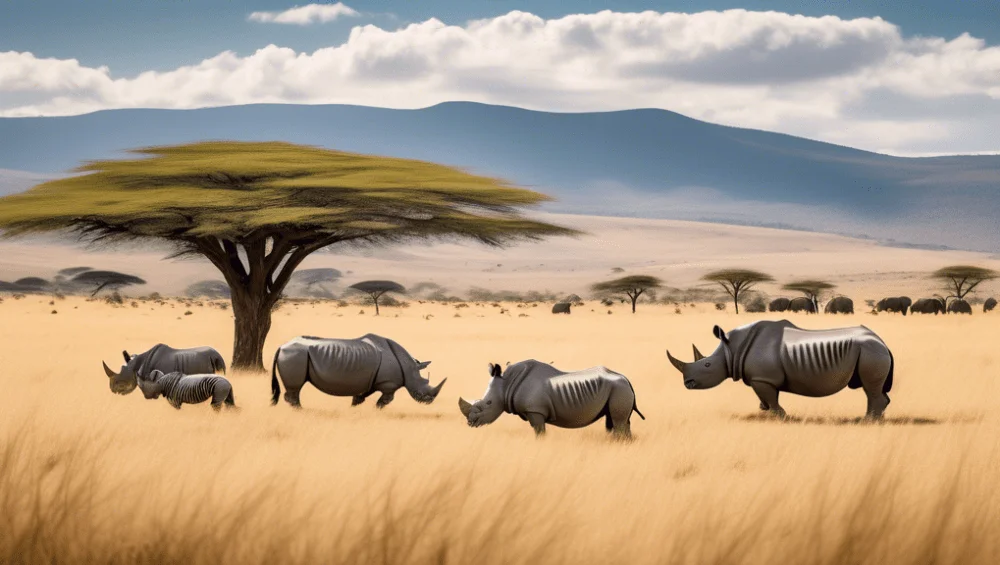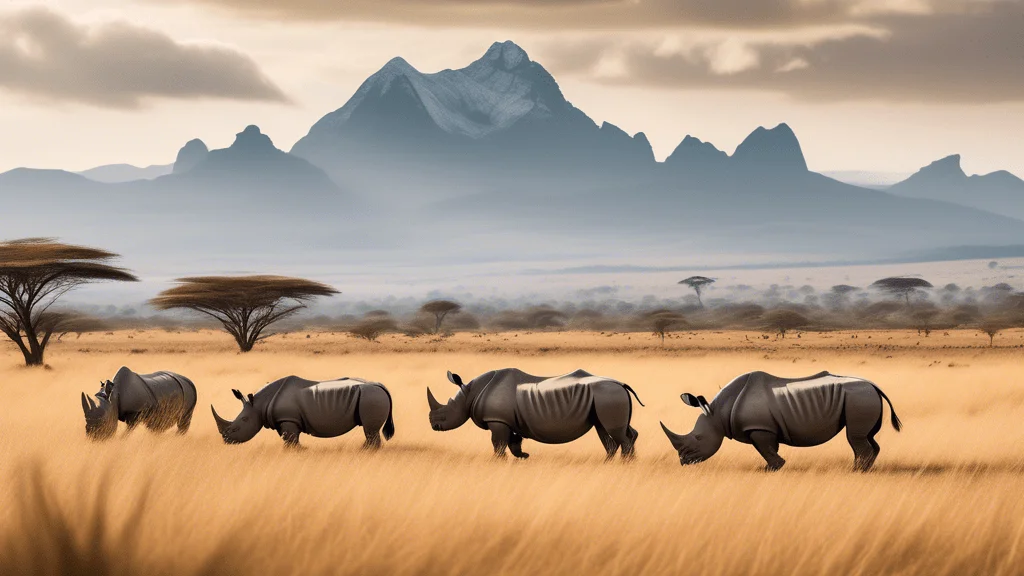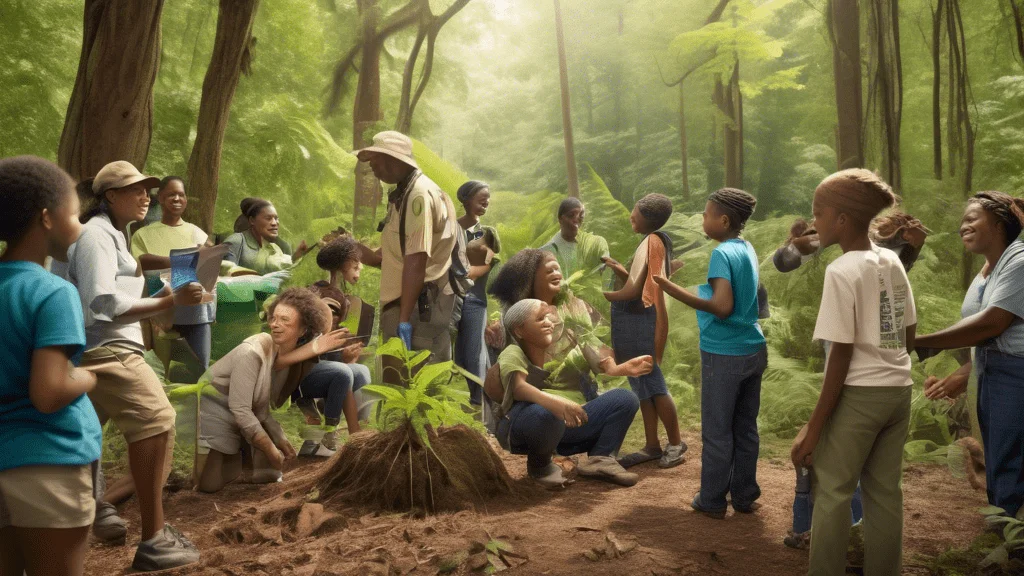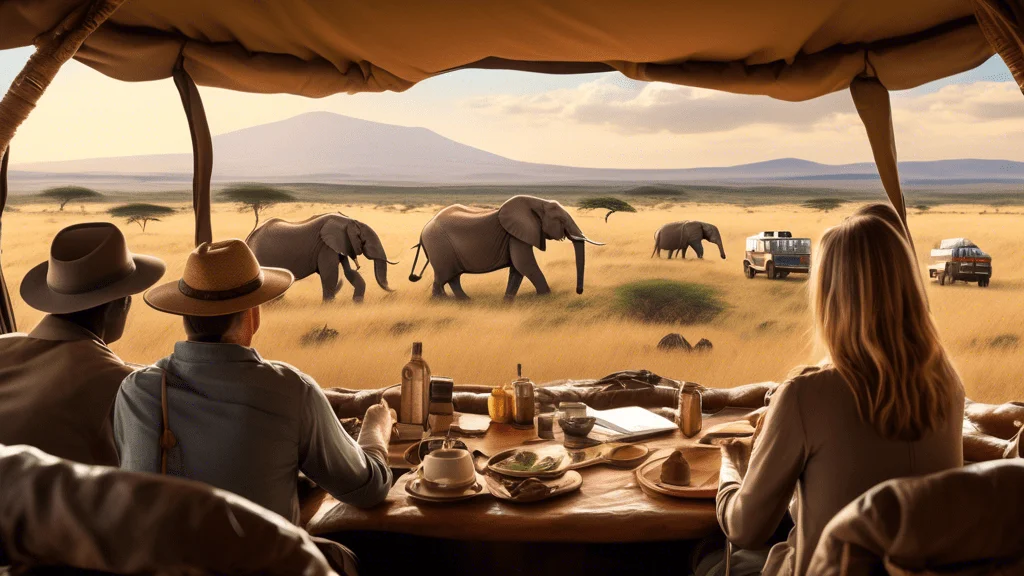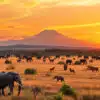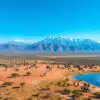Nestled at the foot of Mount kenya Kenya, the Lewa Conservancy is a shining beacon of hope for wildlife conservation. Imagine a place where rolling savannahs meet acacia-dotted landscapes, creating a haven for some of the world’s most endangered species. That’s Lewa Conservancy for you—a sanctuary that not only protects wildlife but also fosters a deep sense of connection with nature.
Why is kenya Kenya considered the heart of wildlife conservation? It’s simple—kenya Kenya is home to a rich tapestry of biodiversity that we can’t afford to lose. From the Big Five to tiny, lesser-known species, this country has long been a focal point in the global conservation narrative. But what sets Lewa Conservancy apart? I mean, there are countless wildlife reserves, right?
Well, Lewa is not just any wildlife conservancy. It stands out for its unique blend of conservation excellence, innovative community engagement, and sustainable tourism. It’s a place where you can witness firsthand the remarkable efforts taken to save species teetering on the brink of extinction. If you’ve ever wanted to see the last remaining strongholds of creatures like the critically endangered black rhino or the iconic, yet vulnerable, reticulated giraffe, Lewa is the place to be.
Here, the story goes beyond just preserving wildlife; it’s about inclusive conservation that involves local communities, educational programs, and sustainable practices. When you step into Lewa, you don’t just get a safari experience—you become part of a larger mission, one that’s rewriting the future of wildlife conservation in kenya Kenya.
So, ready to dive into the world of Lewa Conservancy? Buckle up! We’ll explore how this incredible sanctuary is making waves in rhino conservation, the diverse wildlife that calls it home, and how you can get involved—all while enjoying an unforgettable adventure.
Introduction to Lewa Conservancy
Brief Overview of Lewa Conservancy
Have you ever wondered what it feels like to step into a real-life Noah’s Ark, a place where endangered species are given a second chance? That’s Lewa Conservancy for you. Nestled at the base of the snow-capped Mount kenya Kenya, Lewa is a shining example of how dedicated conservation efforts can turn the tide for endangered wildlife. Spanning over 62,000 acres, this private reserve is not just any piece of land in kenya Kenya; it’s a sanctuary where nature thrives and the spirit of conservation is alive and well.
Importance of Wildlife Conservation in kenya Kenya
Why is wildlife conservation such a big deal in kenya Kenya? If you’ve ever seen a documentary featuring majestic African savannahs, you’ll understand the allure. kenya Kenya is home to some of the world’s most iconic wildlife, from the Big Five to lesser-known but equally fascinating species. However, these animals are under constant threat from poaching, habitat loss, and human-wildlife conflict. Enter places like Lewa Conservancy. By preserving these vital habitats, Lewa not only protects individual species but also maintains the delicate balance of the ecosystem.
Unique Attributes of Lewa Conservancy
So, what sets Lewa Conservancy apart from other wildlife reserves in kenya Kenya? For starters, Lewa’s landscape is incredibly diverse, ranging from rolling savannahs to dense forests and riverine gorges. This varied terrain provides a haven for a wide array of species. But that’s not all. Lewa is a pioneer in using innovative conservation methods, and its community-centered approach sets it apart. You’ll find advanced anti-poaching measures, sophisticated wildlife monitoring systems, and a strong focus on community involvement. It’s not just a conservancy; it’s a holistic model for sustainable conservation.
Ever heard of a conservancy having its own canine unit to sniff out poachers? Well, Lewa does. And let me tell you, these dogs are not just any dogs—they’re real heroes in the fight against poaching. They’ve helped drastically reduce poaching incidents, making Lewa one of the safest sanctuaries for rhinos and other endangered species. Oh, and speaking of rhinos, Lewa is renowned for its successful rhino conservation programs. Curious to learn more about that? Stick around, you’re in for a treat.
Lewa also engages heavily with local communities, ensuring that conservation efforts benefit people as much as they do wildlife. Through educational programs, healthcare services, and sustainable agriculture projects, Lewa helps uplift the surrounding communities. This, in turn, fosters a sense of ownership and responsibility towards preserving the natural heritage. It’s a ripple effect: the better the communities fare, the more robust the conservation efforts become. Now that’s what I call a win-win situation.
For all you aspiring eco-warriors out there, Lewa is also a treasure trove of learning opportunities. The conservancy offers educational programs and internships, creating the next generation of conservationists. Who knows? Maybe you’ll be inspired to embark on your own journey to protect our planet.
In summary, Lewa Conservancy is a remarkable blend of magnificent landscapes, cutting-edge conservation techniques, and community empowerment projects. Its significance extends beyond just wildlife protection; it’s a holistic approach to conservation that promises a sustainable future for both people and nature. Whether you’re a seasoned wildlife enthusiast or just someone who cares about our planet, Lewa Conservancy is a beacon of hope and a testament to what dedicated efforts can achieve.
Ready to explore more about Lewa? Let’s dive into what makes it the ultimate sanctuary for rhinos and other rare species in the next section!
Rhinos: The Jewel of Lewa Conservancy
History of Rhino Conservation Efforts at Lewa
When I first visited Lewa Conservancy, I was struck by the majestic rhinos roaming freely in their natural habitat. But it hasn’t always been this way. Back in the 1980s, rhino populations were alarmingly low due to rampant poaching. Lewa began its dedicated rhino conservation efforts in the early 1990s, around the time when poaching was at its peak. This commitment marks the beginning of an inspiring journey of wildlife protection.
Imagine a place where only a handful of these magnificent creatures survived. Doesn’t it feel like a miracle that today, Lewa is home to significant numbers of both black and white rhinos? I remember reading about how Lewa’s founders, David and Delia Craig, made it their mission to create a safe haven for rhinos on their cattle ranch, transforming it into the comprehensive conservancy that exists now.
Current Rhino Population and Species
Today, Lewa Conservancy stands proudly as a stronghold for rhinos. Housing approximately 15% of kenya Kenya’s total rhino population, the conservancy is a beacon of hope for their survival. As of the latest counts, they host over 90 black rhinos and 70 white rhinos. Isn’t that an incredible turnaround?
Black rhinos and white rhinos have distinct characteristics and needs. Black rhinos, which are critically endangered, tend to be more solitary and are browsers, meaning they eat leaves from bushes. White rhinos, on the other hand, are more social and graze on grasses. It’s fascinating how the conservancy has adapted to cater to both species, creating an environment where they can thrive. Have you ever wondered how such a delicate balance is maintained? The secret lies in skilled wildlife management and constant monitoring.
Success Stories and Challenges in Rhino Protection
One of my favorite stories from Lewa is the rescue and rehabilitation of a rhino named Laikipia. She was found orphaned in the wild, her mother a victim of poaching. The dedicated team at Lewa nursed her back to health, and today, Laikipia roams the conservancy along with her own young calf. It’s such stories that warm your heart and reaffirm the importance of conservation efforts.
But let’s not sugarcoat it. Protecting rhinos comes with its own set of challenges. Poaching remains a significant threat, fueled by the black market demand for rhino horns. Lewa has had to adopt stringent security measures, including anti-poaching units, surveillance technology, and community intelligence networks. I once spoke to a ranger who shared harrowing tales of nightly patrols, yet his eyes shone with determination – it’s not just a job, it’s a cause.
Another challenge is habitat space. With the increasing rhino population, there’s a constant need to expand and create more space without disrupting the ecosystem balance. It’s a bit like trying to solve a complex puzzle, isn’t it? Yet, through carefully planned land management practices, Lewa ensures these giants have ample space to roam and breed.
Despite the hurdles, the success stories outshine the difficulties. Each birth of a new rhino calf is celebrated like a small victory. And what’s truly remarkable is how these efforts have also benefited other species, contributing to a richer, more diverse ecosystem.
Next time you’re contemplating a travel destination or cause to support, why not consider Lewa Conservancy? It’s a place where every visit contributes to the ongoing success story of rhinos and a testament to what sustained conservation efforts can achieve. Plus, there’s nothing quite like seeing a rhino in the wild, knowing that you’re standing in a place where history and hope converge.
The Diverse Wildlife of Lewa Conservancy
Overview of Rare and Endangered Species
When it comes to biodiversity, Lewa Conservancy is like an all-you-can-eat buffet of rare and endangered species. It’s astonishing how many unique animals call this place home. Have you ever thought about what it means to stumble upon a species that you can’t find anywhere else? For me, it’s like discovering a hidden gem in your backyard. Lewa offers that thrill every single day.
The conservancy is home to over 70 different mammal species and more than 350 bird species. Yes, you read that right! It’s a feast for those who adore nature in all her glory. From the endangered Grevy’s zebra to the elusive African wild dog, Lewa is a sanctuary where these rare animals can thrive.
Grevy’s Zebra: The Stripe King
Let’s talk about one of the standout residents of Lewa Conservancy—the Grevy’s zebra. If there were a ‘most stylish animal’ award, this zebra would certainly be in the running. Grevy’s zebra is distinct with its narrow stripes and large round ears, making it look like it’s always wearing a designer outfit.
A few years back, I was lucky enough to observe a herd of Grevy’s zebra during a game drive. Seeing them graze peacefully against the backdrop of kenya Kenya’s stunning landscapes was an experience I’ll never forget. But it’s not all picturesque moments; these zebras are endangered, largely due to habitat loss and competition with livestock for water and grazing lands. Lewa Conservancy has been instrumental in providing a safe haven for these magnificent creatures, allowing their numbers to gradually increase.
Reticulated Giraffe: Nature’s Towering Beauty
Next up is the reticulated giraffe, another celebrity resident of Lewa. If you’ve ever seen a giraffe up close, you’ll know they’re more than just tall. Their unique, geometric patchwork pattern is nothing short of nature’s art.
One sunny morning, as I was sipping my coffee at one of the lodges, I saw a reticulated giraffe gracefully glide across the plains. It was as if time slowed down for that serene moment. These giraffes face the challenge of poaching and habitat destruction, but thanks to concerted efforts at Lewa, their population is being carefully monitored and protected.
Importance of Biodiversity in the Ecosystem
So, why does all this matter? What’s the big deal about preserving these species? Well, biodiversity isn’t just a fancy buzzword; it’s the cornerstone of a healthy ecosystem. Imagine trying to build a puzzle with missing pieces—doesn’t quite work, does it?
Each animal and plant species in Lewa plays a crucial role in maintaining the balance of nature. Predators keep prey populations in check, herbivores contribute to the health of plant life, and birds help in seed dispersal. It’s a beautiful, intricate web of interactions that sustain the environment. Lose one species, and you risk disrupting this balance, leading to cascading effects that can potentially harm the entire ecosystem.
Lewa Conservancy understands this delicate balance and works tirelessly to ensure that every species, no matter how rare or endangered, gets the protection it deserves. This commitment not only helps to preserve kenya Kenya’s natural heritage but also contributes to global biodiversity.
So, next time you think about wildlife conservation, remember it’s not just about saving one species at a time. It’s about preserving the dazzling dance of life itself, one that we are all a part of, whether we’re in the middle of kenya Kenya or sitting at home reading about it.
Community and Conservation Efforts
Engagement with Local Communities
Have you ever wondered how a place like Lewa Conservancy manages to protect its wildlife successfully? One of the most significant factors is community involvement. You see, effective conservation isn’t just about saving animals; it’s about creating a harmonious relationship between wildlife and people. Lewa has mastered this art. By engaging with local communities, the conservancy ensures that everyone has a stake in its success.
Take, for instance, the local Samburu and Borana communities. Through various outreach programs, Lewa educates and involves these communities in conservation efforts. Now, instead of seeing wildlife as a threat to their crops and livestock, people understand the benefits of protecting these animals. Isn’t that a win-win?
Educational Programs and Initiatives
You might think, Okay, getting the local communities involved is great, but how exactly does Lewa do it? One of the key strategies is education. The conservancy runs a series of educational programs and initiatives aimed at spreading awareness about the importance of wildlife conservation. Schools in neighboring areas are often invited to visit the conservancy for educational tours. These tours aren’t just about showing kids animals; they delve into the science of ecology and the importance of preserving biodiversity. Imagine the curiosity and excitement it sparks in these young minds!
I remember visiting an open classroom near one of the local villages. The enthusiasm of the kids was infectious. They had learned about the unique animals of Lewa, such as the critically endangered Grevy’s zebra, and the resilience of the black rhino. These programs aren’t just initiatives; they’re investments in the future guardians of Lewa.
Sustainable Tourism and Its Impact on Conservation
Let’s talk a bit about tourism, shall we? Specifically, sustainable tourism. When I first visited Lewa, I was struck by how seamlessly the conservancy blends tourism with conservation. Unlike other more commercialized destinations, Lewa offers an experience that not only awes but educates visitors about the importance of conservation. And trust me, it makes a difference.
But why should you care about sustainable tourism? For one, it provides a significant source of revenue that is plowed back into conservation efforts. By visiting Lewa, you’re directly contributing to the preservation of endangered species. Not too shabby for a vacation, right? The funds generated from tourism help in maintaining the conservancy, supporting ranger patrols, and enhancing community programs. It’s this integrated approach that makes Lewa a model for conservation efforts worldwide.
How does Lewa manage to keep tourism sustainable? Exclusive lodges minimize their impact on the environment and follow strict guidelines that focus on eco-friendly practices. You won’t find plastic bottles lying around here. Instead, what you will find are informative guides passionate about sharing the story of Lewa, its mission, and how every little bit helps.
Living in a world where we often hear about the negative impact of tourism, it’s heartening to see a place getting it right. Sustainable tourism at Lewa isn’t just a buzzword; it’s a philosophy. It’s about creating meaningful experiences that benefit both the visitor and the conservancy.
So, the next time you’re planning a getaway, why not consider a trip that allows you to unwind while also contributing to a greater cause? I promise, the satisfaction you’ll get from knowing you’re aiding wildlife conservation is hard to beat.
How to Visit and Support Lewa Conservancy
Travel Tips and Best Times to Visit
Planning a trip to Lewa Conservancy? You’re in for an adventure of a lifetime! Trust me, if you’re anything like me, you’ll want to soak in every moment. But, let’s get real – timing is everything. The prime time to visit is during kenya Kenya’s dry season, between June and October. Why? Because the wildlife is more concentrated around water sources, making it easier to spot those elusive creatures you came to see.
Pack light, but essential – sunscreen, a good pair of binoculars, and a camera with extra memory cards (you’ll thank me later). Comfortable, breathable clothing is a must. Think safari hats and khaki pants. Oh, and don’t forget those sturdy walking shoes. Lewa is all about exploring, and you don’t want blisters putting a damper on your excitement.
Ways to Contribute to Conservation Efforts
Sure, visiting Lewa is incredible, but what if you want to do more than just bask in its beauty? There are plenty of ways to give back and make a real impact. Donations are always welcome. Did you know that just a small contribution can feed a rhino for a day? That’s right, your extra coffee money can make a significant difference.
If you’re feeling a bit more hands-on, volunteering is another fantastic option. I once met a couple who spent their vacation helping with wildlife tracking and anti-poaching efforts. They said it was the most rewarding experience of their lives. Not only did they help protect these magnificent animals, but they also gained a deeper understanding of the conservation challenges and triumphs.
Another way to support Lewa is by spreading the word. Ever heard of the phrase, if you love something, set it free? Well, in the digital age, that means sharing photos, stories, and posts on social media. Your vacation snaps could inspire others to visit or donate. It’s like a ripple effect, and you can be the pebble that starts it all.
Future Plans and Developments for the Conservancy
Lewa Conservancy isn’t just resting on its laurels – it’s always looking ahead. There are exciting developments on the horizon aimed at expanding their conservation efforts and improving visitor experiences. For instance, there are plans to introduce more eco-friendly accommodations. Imagine luxury tents powered by solar energy, blending in seamlessly with the landscape. Sounds like a dream, right?
They’re also working on enhancing their educational programs. I’ve heard whispers about virtual reality (VR) experiences that could bring the wonders of Lewa to classrooms around the world. Picture kids in New York or Tokyo learning about rhino conservation through immersive, 360-degree videos. It’s the future of education, and Lewa is at the forefront.
The conservancy is also focusing on strengthening partnerships with local communities. The goal is to create a win-win scenario where both wildlife and people thrive. Initiatives like sustainable farming and eco-tourism projects are in the pipeline. Every step they take ensures a better, more sustainable future for everyone involved.
So, whether you’re planning a visit, looking to donate, or just keen to stay informed, there’s always a way to support and be a part of Lewa’s success story. Let’s make our footprints matter!
Conclusion: Lewa Conservancy – A Symbol of Hope and Commitment
By now, it’s clear that Lewa Conservancy isn’t just a sanctuary for wildlife; it’s a vibrant testament to what can be achieved through dedication, collaboration, and a genuine love for nature. From the triumphant return of rhinos from the brink of extinction to the thriving populations of Grevy’s zebras and reticulated giraffes, Lewa represents the remarkable success stories that inspire conservationists worldwide. But beyond the statistics and the beautiful landscapes, what truly stands out is the heart of Lewa: its community.
Reflecting on the Power of Community
Can you imagine a place where local communities are not just bystanders but active participants in conservation? Lewa has made this a living reality. The educational programs, sustainable tourism initiatives, and employment opportunities created for locals not only foster a sense of ownership and pride but also provide practical, everyday benefits that ripple outwards, creating a robust network of conservation champions. It’s not just about saving animals; it’s about building resilient, interconnected ecosystems that include people.
Your Role in This Journey
Visiting Lewa Conservancy isn’t just another travel experience; it’s a chance to witness conservation in action and to contribute directly to its ongoing success. Whether you’re planning your trip to align with the best wildlife viewing times or considering a donation or volunteer stint, your involvement makes a significant impact. The conservancy’s future developments promise even more opportunities for engagement and growth, ensuring that Lewa remains a haven for generations to come.
And let’s face it—who wouldn’t want to be part of such a hopeful and vibrant story? As you plan your next adventure, think about how your choices can support places like Lewa. Imagine walking through its vast landscapes, knowing that each step you take helps protect a rhino, educate a child, or sustain a community. After all, in the grand tapestry of life, every thread counts.
So, next time you’re contemplating where you want your travel dollars to go or considering how to make a difference, remember Lewa. It’s more than just a conservancy—it’s a beacon of what we can achieve when we work together for a common cause.

